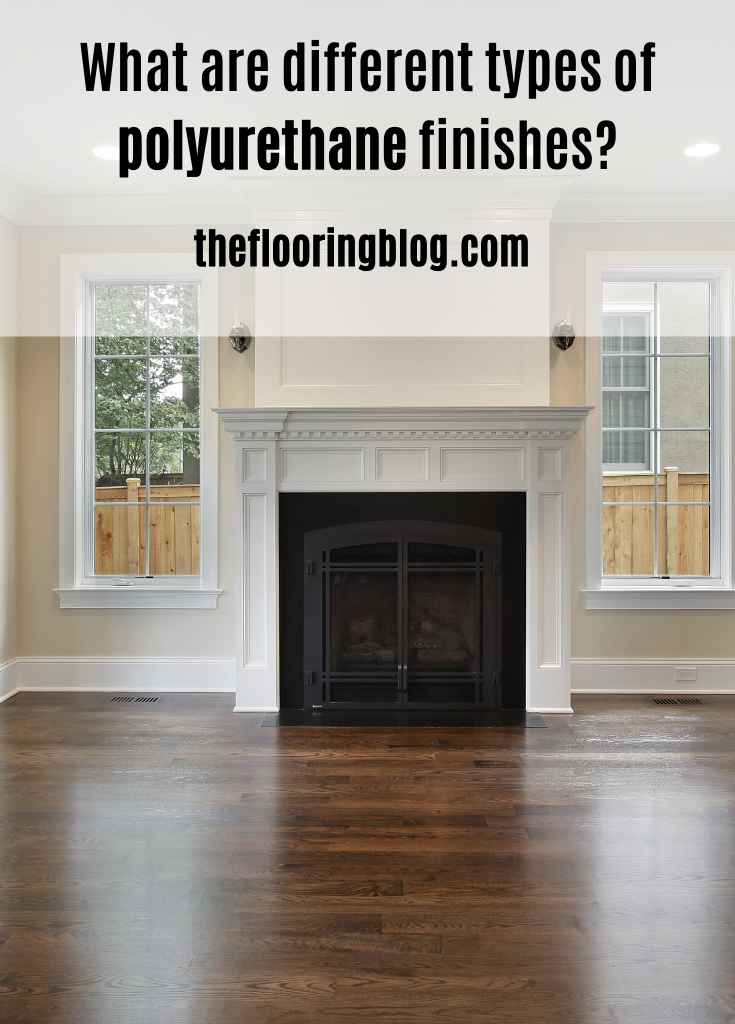
What are different types of polyurethane finishes?
Matte- Satin- Semi-gloss- High gloss
How is flooring luster measured?
The luster, or “sheen level” of a floor is determined by how the flooring surface reflects light at a particular angle. The luster is measured with a small device called a gloss meter, which measures the amount of reflected light from the light beamed at a given angle onto the floor. This gives us our “scale;” with “Matte” on one end, (being the least glossy and reflective, and “High gloss” on the other end, (being the most shiny and most reflective of the finishes).
Does polyurethane affect the color of a hardwood floor?
The simple answer is: It depends on whether you’re using an oil based poly or a water bourn poly:
Oil based poly has a yellow tint to it. When applied to a hardwood floor as a natural finish it will amber over time and turn into a warm, light colored floor which usually looks like a Golden Oak color. This happens over many years. If you’re going to stain your hardwood floors a light color- it may darken it a bit and become a warmer shade; (but not too much). On dark-stained hardwood floors, the yellow tint to the polyurethane will not have much effect on the color at all. However, oil-based polyurethane will horribly affect a gray or white washed hardwood floor and for this reason we ALWAYS use water bourn polyurethane for these finishes.
Oil based polyurethane will also effect the color of a maple hardwood floor. Maple flooring is, most commonly installed because of its natural creamy, light color and very rarely stained because of this. When applying an oil-based poly, it will turn the Maple hardwood floors a warm light-yellow color. For this reason, it’s completely recommended to apply a water bourn polyurethane on this particular species of hardwood flooring to avoid this yellowing effect.
The various sheen levels of polyurethane are not what affect the color of the hardwood flooring. What affects the color is the polyurethanes composition; whether you choose an oil based polyurethane or a water bourn polyurethane will determine the amount of amber or yellow tint you receive. As stated above, water bourn polyurethane has little to no tint, regardless of the level of sheen; (which is why it is recommended and often used as the finish for white washed, gray or natural maple hardwood floors). Oil base polyurethane not only has a warm golden hue, making natural hardwood flooring warmer in color, but also ambers over time. This warm color hue, and ambering effect, will happen regardless of the level of sheen in the oil based polyurethane. If you choose a matte finish, oil-based polyurethane, the yellowing effect will be the same as if you choose a high gloss finish, oil-based polyurethane for your hardwood flooring.
What’s the difference between matte, satin, semi-gloss and high-gloss polyurethane finishes?
The basic difference between each finish is the way in which light is reflected off of it. One isn’t necessarily more durable than the next. The lower the level of sheen, the less likely you are to see scratches, scuffs or dirt on your hardwood floors, this is because light reflects off of a finish with a high sheen level more than a finish with a low sheen level.
Matte Polyurethane has a very low luster/sheen level. Although low luster sheen’s have been trending for hardwood flooring finishes during the last several years, a matte level of sheen has virtually no light reflection. Many customers do not realize just how dull this finish is, as opposed to the high gloss finish. Some people absolutely LOVE the matte-look, while others just weren’t expecting it to be such a low luster finish. The finish is really up to preference, and is totally an aesthetic choice.
Satin Polyurethane is next on the “sheen spectrum” and it also happens to be the most popular choice of finish for hardwood flooring today.
Already popular in Europe, low luster hardwood flooring is gaining popularity in North America and offers a wide range of benefits for consumers. By becoming more familiar with these benefits and the basics of low-luster floors, you can make the most of this trend.
Currently satin finish is in high demand and recommended most by professionals today. A “Satin” finish has a medium to low sheen/luster and hides dirt and scratches better than a gloss or high gloss polyurethane finish. The Satin finish is the median point of the sheen levels; it kind of possesses the best of both ends of the sheen-spectrum; Satin has the benefits of the matte finish, in that it can hide scratches well, while still being clear enough to see all the beautiful graining in your hardwood floor. The Satin finish is popular today because it’s easy to live with; you won’t see annoying smudge marks from footprints, or obvious pet scratches like you would with a high gloss finish; yet it’s not cloudy like a Matte finish may appear to be. Low-luster floors are easier to maintain and clean than high-gloss varieties; it is easier to keep the natural look of the floor because there is less “shine” to maintain. Again, this is less work and less worry for homeowners, especially those who live in areas where harsh weather conditions bring a lot of moisture and dirt into the house.
Semi-Gloss Polyurethane:
Semi-Gloss Polyurethane is the next polyurethane sheen option on the “luster scale.” This is usually as shiny as most people would prefer to go when finishing the hardwood flooring in their homes. This isn’t because it doesn’t make their hardwood flooring look clear and beautiful, (because it absolutely does!) It’s more commonly not chosen due to the fact that it requires more up-keep than a “satin” or “matte” finished floor. The Semi-gloss finish is a bit shinier in an oil-based polyurethane than a waterborne one. Semi-gloss polyurethane is clear, shiny, and not really recommended for households with pets, or small children. As stated above; the shinier you go, the more noticeable scratches, dents, scuff marks, and imperfections, (even dirt on the floor) will be.
Gloss / High Gloss Polyurethane:
High gloss has the highest luster level of all the finishes. This is not often used for high traffic hardwood floors. A “High gloss” finish is more likely to be seen on specialty hardwood species, like exotic hardwoods, so that the natural beautiful graining is, not only, seen, but emphasized. A “High gloss” finish just might drive you a bit crazy if you’re thinking about it for a kitchen or dining room, and if you have pets and small children running around. Our customers who choose the “High gloss” finish are usually choosing it because they have installed a beautiful exotic hardwood floor, or one with an accent pendant or flooring border. Not usually where there will be heavy foot traffic, or pets. High gloss is notorious for making dust, streaks from cleaning, pet hair, water spots, scratched, dirt and dents, much more apparent.
Is one more durable than the other?
The answer of durability lies with whether you choose to apply an oil based polyurethane finish or a waterborne one. Oil based polyurethane is more durable and lasts longer (especially in high traffic areas of your home) than waterborne polyurethane.
The durability and longevity of each polyurethane finish is not affected by the choice of sheen level. An oil based polyurethane in a matte finish is just as durable as an oil based polyurethane in a gloss finish. The only thing that differs is the appearance and the ability to hide scratches, scuffs and dirt on your hardwood floor. The same rule goes for waterborne polyurethane; a waterborne polyurethane in a matte finish will have the same durability as a waterborne polyurethane in a gloss finish.
Note: an oil based polyurethane in ANY finish is more durable and lasts longer than a waterborne polyurethane in ANY of the finish choices.
Are the waterborne finishes different than the oil based finishes?
Yes, very much so! In our experience, for example, Waterborne polyurethane in a “Satin” looks a bit like the equivalent of an oil based polyurethane in a “Matte” finish. Besides from aesthetics, the waterborne polys do not hold up as well as oil based polys. Oil dries and cures more solid than water. Also, oil is also more scratch and ware resistant. However, oil based polys have a higher VOC level than water. You can read more about the difference between oil and water based polyurethane here: Oil VS Water bourn polyurethane
VOC levels: By their nature, waterborne coatings have lower VOC levels than most other wood floor finishes. Traditional waterborne finishes are compliant with VOC laws, and manufacturers have created products that meet new regulations in some regions. Some manufacturers have developed even-lower-VOC products to appeal to consumers with environmental or health concerns.
What if I don’t like the finish/sheen level, can I change it?
Yes, you can absolutely change your sheen level with a simple screen and recoat-SO LONG as you are changing the poly with a like for like base (for example- you want to change from an oil semi-gloss poly to a satin finish, you must use a satin OIL based poly.) You cannot mix water and oil finishes. If you wanted to change from oil to water or vice versa, you must wait a minimum of 6 months before doing so.
I hope this article helps in your flooring decisions. As always, feel free to contact me anytime at info@theflooringblog.com or theflooringblog@gmail.com with any questions or concerns you may have.

Feel free to share this article on all of your social media sites!
*Lisa


163 Comments
Pingback:
Pingback:
Pingback:
Pingback:
Pingback:
Pingback:
Pingback:
Pingback:
Pingback:
Pingback:
Pingback:
Pingback:
Pingback:
Pingback:
Pingback:
Pingback:
Pingback:
Pingback:
Pingback:
Pingback:
Pingback:
Pingback:
Pingback:
Pingback:
Pingback:
Pingback:
Pingback:
Pingback:
Pingback:
Pingback:
Pingback:
Pingback:
Pingback:
Pingback:
Pingback:
Pingback:
Pingback:
Pingback:
Pingback:
Pingback:
Pingback:
Pingback:
Pingback:
Pingback:
Pingback:
Pingback:
Pingback:
Pingback:
Pingback:
Pingback:
Pingback:
Pingback:
Pingback:
Pingback:
Pingback:
Pingback:
Pingback:
Pingback:
Pingback:
Pingback:
Pingback:
Pingback:
Pingback:
Pingback:
Pingback:
Pingback:
Pingback:
Pingback:
Pingback:
Pingback:
Pingback:
Pingback:
Pingback:
Pingback:
Pingback:
Pingback:
Pingback:
Pingback:
Pingback:
Pingback:
Pingback:
Pingback:
Pingback:
Pingback:
Pingback:
Pingback:
Pingback:
Pingback:
Pingback:
Pingback:
Pingback:
Pingback:
Pingback:
Pingback:
Pingback:
Pingback:
Pingback:
Pingback:
Pingback:
Pingback:
Pingback:
Pingback:
Pingback:
Pingback:
Pingback:
Pingback:
Pingback:
Pingback:
Pingback:
Pingback:
Pingback:
Pingback:
Pingback:
Pingback:
Pingback:
Pingback:
Pingback:
Pingback:
Pingback:
Pingback:
Pingback:
Pingback:
Pingback:
Pingback:
Pingback:
Pingback:
Pingback:
Pingback:
Pingback:
Pingback:
Pingback:
Pingback:
Pingback:
Pingback:
Pingback:
Pingback:
Pingback:
Pingback:
Pingback:
Pingback:
Pingback:
Pingback:
Pingback:
Pingback:
Pingback:
Pingback:
Pingback:
Pingback:
Pingback:
Pingback:
Pingback:
Pingback:
Pingback:
Pingback:
Pingback:
Pingback:
Pingback:
Pingback:
Pingback:
Pingback:
Pingback:
Pingback:
Pingback: